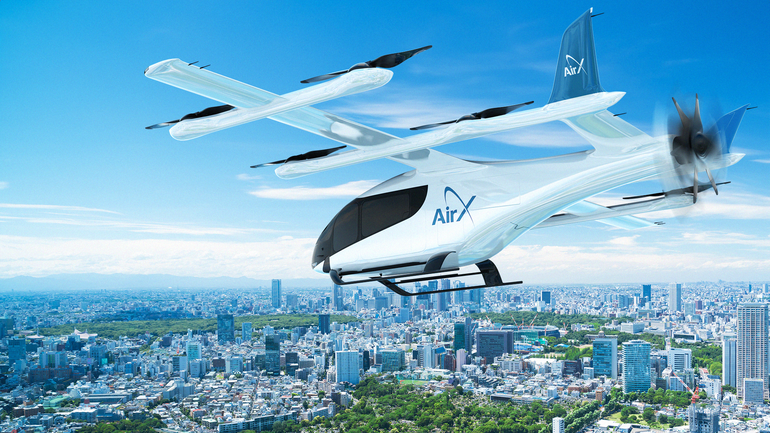
With projects in areas such as electric vertical take-off and landing vehicles (eVTOLs) under its belt, the innovation unit of Brazilian aerospace conglomerate Embraer is placing its bets on projects aimed at decarbonizing aviation.
Embraer-X was created in 2017 as an incubator for disruptive innovation within Embraer. The goal for the US-based unit is to focus on ideas that have a high level of uncertainty and risk, which were often deprioritized in the past due to their deviation from the parent company’s core business.
“We can’t be resting on our laurels forever, and we also didn’t want to be victims of disruption in our sector: rather, we want to be leaders of this disruption,” said Daniel Moczydlower, president of Embraer-X, on the sidelines of the innovation conference Web Summit Rio, which took place last month.
When ideas didn’t have a sponsor and were promising but catered to clients that perhaps didn’t even exist, they were left without ‘parents’ to feed them so they could grow and develop. “Having a structured area to nurture and protect these innovative ideas was crucial to making things work,” said Moczydlower.
In terms of revenue contribution of Embraer-X to its parent company, the head of the unit mentioned that innovations introduced in the past five years currently account for approximately 40% of Embraer’s revenue. The goal is to maintain and potentially increase this contribution in the future, with a target of reaching 50%, he noted.
However, the president of Embraer-X acknowledged the challenge of sustaining this level of revenue contribution, as it requires a continuous stream of new product launches.
“But we are committed to maintaining our position as a leader in innovation within the aviation industry,” the executive said, noting the initiatives around decarbonization will play a significant role in the process.
Decarbonization plans
In 2022, the International Civil Aviation Organization (ICAO) set a goal for international aviation to achieve net-zero CO2 emissions by 2050. Achieving this ambitious target may require up to $5 trillion in investments in clean aircraft and fuels.
Reducing carbon emissions is one of the main areas of focus in the projects Embraer-X leads. Its parent company has set a goal of becoming carbon neutral for their direct emissions and energy consumption by 2040.
“The question is, how are we going to honor the commitments we have already made to carbon-neutral aviation? We know it’s very challenging, as batteries solve the issue of short flights – but what about longer flights?” Moczydlower said.
“For slightly larger planes, at intermediate distances, there is the possibility of looking at hydrogen fuel cells, as they generate electrical energy on board to fuel the aircraft. For longer distances and planes that carry more cargo and passengers, perhaps even burning hydrogen in the turbine is a possibility that we are looking at, since it is a clean burn,” he added.
In addition, Embraer-X is looking at the potential of sustainable aviation fuel (SAF). This, according to Moczydlower, is about making current aircraft compatible with the use of 100% SAF and finding ways to create synthetic fuel or produce fuel from renewable sources. This could include carbon dioxide taken from the atmosphere, ethanol, sugarcane, cellulose, or even recycled cooking oil.
“All these paths have challenges, we are studying all of these things – but this could be a way to reduce carbon emissions from aviation,” the executive said.
Life after Eve
The greatest “hit” for Embraer-X since its inception is Eve Air Mobility, a spin-off company focused on the development of VTOLs, which has already achieved significant milestones, including a NYSE IPO in 2022.
According to Moczydlower, the first prototype in real size for Eve’s “flying car” will be produced before year-end at Embraer’s factory in Taubaté (87 miles from São Paulo). Embraer-X’s head noted the importance of Embraer’s expertise in the success of Eve: “Our engineering know-how is our greatest competitive advantage.”
Eve has nearly 3,000 orders to be fulfilled, Embraer-X’s president said, and is hoping to have the first real-size VTOL prototype ready by year-end. His expectation is that when the flying cars are fully operational, some 500 VTOLs will be up in the air in a city like São Paulo. “That compares to up to a dozen helicopters that can currently operate at the same time,” he pointed out.
Eve being an offspring with its own life, the innovation unit is now focusing on other projects. These include the development of Vector, a software aimed to address the future challenge of managing air traffic in urban areas. “[Vector] is being developed in parallel with [Eve’s VTOL] and will have its own market,” Moczydlower said.
Another area of focus for Embraer-X is Beacon, a digital solution incubated by the unit that connects mechanics with airlines to efficiently resolve aircraft maintenance issues. The Tinder-like platform has already been incorporated into Embraer’s support services portfolio.
Looking towards the future, Moczydlower acknowledged that the biggest challenge in achieving Embraer-X’s goals is the cultural shift required within the company.
In that process, nurturing talent and a forward-thinking mindset will be key to driving success, as well as combining disruptive approaches with Embraer’s tradition, according to the innovation unit’s head: “Balancing innovation with the company’s legacy and expertise is crucial.”
